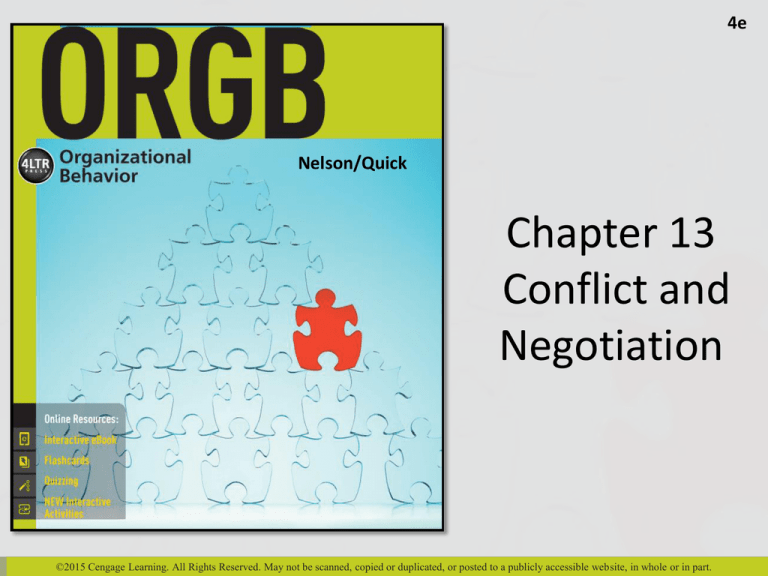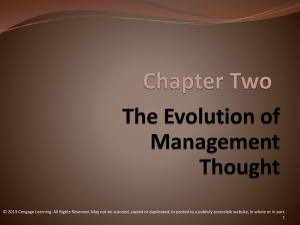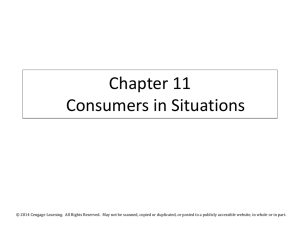
4e
Nelson/Quick
Chapter 13
Conflict and
Negotiation
©2015 Cengage Learning. All Rights Reserved. May not be scanned, copied or duplicated, or posted to a publicly accessible website, in whole or in part.
Learning Outcomes
Describe the nature of conflicts in organizations
Explain the role structural and personal factors play
in causing conflict in organizations
Discuss the nature of group conflict in organizations
Describe the factors that influence conflict between
individuals in organizations
Describe effective and ineffective techniques for
managing conflict
Identify five styles of conflict management
©2015 Cengage Learning. All Rights Reserved. May not be scanned, copied or duplicated, or posted to a publicly accessible website, in whole or in part.
2
Learning Outcome
Describe the nature of conflicts in
organizations
©2015 Cengage Learning. All Rights Reserved. May not be scanned, copied or duplicated, or posted to a publicly accessible website, in whole or in part.
3
Conflicts
Disagreement between two or more parties due to
incompatible goals, attitudes, emotions, or
behaviors
Magnified by increasing competition, globalization,
and diversity
©2015 Cengage Learning. All Rights Reserved. May not be scanned, copied or duplicated, or posted to a publicly accessible website, in whole or in part.
4
Importance of Conflict Management
Skills
Major predictor of managerial success
Reflection of emotional intelligence (EI)
EI - Power to control one’s emotions and perceive
emotions in others, adapt to change, and manage
adversity
©2015 Cengage Learning. All Rights Reserved. May not be scanned, copied or duplicated, or posted to a publicly accessible website, in whole or in part.
5
Table 13.1 - Consequences of
Conflict
©2015 Cengage Learning. All Rights Reserved. May not be scanned, copied or duplicated, or posted to a publicly accessible website, in whole or in part.
6
Nature of Organizational Conflict
Functional conflict
Dysfunctional conflict
• Healthy, constructive
disagreement
• Results in new ideas, learning,
and growth among individuals
• Improves working
relationships
• Individuals experience
improved morale
• Leads to innovation and
positive change for the
organization
• Unhealthy, destructive
disagreement
• Focuses on the conflict and the
parties
• Drains energy
• Individuals act before thinking
• Leads to aggressive acts or
retaliation
• Losses may exceed any
potential gain from the conflict
©2015 Cengage Learning. All Rights Reserved. May not be scanned, copied or duplicated, or posted to a publicly accessible website, in whole or in part.
7
Diagnosing Conflict
Manager must look at the issue, the context of the
conflict, and the parties involved
After diagnosing the type of conflict:
Work to resolve it
Stimulate it
©2015 Cengage Learning. All Rights Reserved. May not be scanned, copied or duplicated, or posted to a publicly accessible website, in whole or in part.
8
Beyond the Book:
Questions to Use When Diagnosing Conflict
Yes
No
Are the parties approaching the conflict from a
hostile standpoint?
Is the outcome likely to be a negative one for the
organization?
Do the potential losses of the parties exceed any
potential gains?
Is energy being diverted from goal accomplishment?
©2015 Cengage Learning. All Rights Reserved. May not be scanned, copied or duplicated, or posted to a publicly accessible website, in whole or in part.
9
Learning Outcome
Explain the role structural and personal
factors play in causing conflict in
organizations
©2015 Cengage Learning. All Rights Reserved. May not be scanned, copied or duplicated, or posted to a publicly accessible website, in whole or in part.
10
Figure 13.1 - Causes of Conflict in
Organizations
©2015 Cengage Learning. All Rights Reserved. May not be scanned, copied or duplicated, or posted to a publicly accessible website, in whole or in part.
11
Beyond the Book:
Looking for Trouble
A South Carolina woman on probation signed a
court document with instructions as to what body
part the judge could kiss. The judge rewarded her
with an additional 90 days of probation.
The lesson: considering the consequences of your
words can avoid needless conflict and negative
consequences.
©2015 Cengage Learning. All Rights Reserved. May not be scanned, copied or duplicated, or posted to a publicly accessible website, in whole or in part.
12
Learning Outcome
Discuss the nature of group conflict in
organizations
©2015 Cengage Learning. All Rights Reserved. May not be scanned, copied or duplicated, or posted to a publicly accessible website, in whole or in part.
13
Forms of Group Conflict in
Organizations
Interorganizational conflict
• Occurs between two or more organizations
Intergroup conflict
• Occurs between groups or teams
Intragroup conflict
• Occurs within groups or teams
©2015 Cengage Learning. All Rights Reserved. May not be scanned, copied or duplicated, or posted to a publicly accessible website, in whole or in part.
14
Beyond the Book:
AT&T vs. Verizon
Verizon advertisements compare their national 3G
network coverage with that of AT&T.
AT&T sued Verizon in federal court, claiming that
the ads are misleading and requesting that the
Verizon ads be pulled. The judge decided against
AT&T.
AT&T also responded with an anti-Verizon ad that
highlights the iPhone.
©2015 Cengage Learning. All Rights Reserved. May not be scanned, copied or duplicated, or posted to a publicly accessible website, in whole or in part.
15
Learning Outcome
Describe the factors that influence conflict
between individuals in organizations
©2015 Cengage Learning. All Rights Reserved. May not be scanned, copied or duplicated, or posted to a publicly accessible website, in whole or in part.
16
Forms of Conflict in Organizations
Intrapersonal
conflict
•Occurs within an individual
Interpersonal
conflict
•Occurs between two or more
individuals
©2015 Cengage Learning. All Rights Reserved. May not be scanned, copied or duplicated, or posted to a publicly accessible website, in whole or in part.
17
Figure 13.2 - An Organization
Member’s Role Set
SOURCE: J. C. Quick, J. D. Quick, D. L. Nelson, and J. J. Hurrell Jr., Preventive Stress Management in Organizations (Washington, DC: American Psychological
Association, 1997). Copyright © 1997 by the American Psychological Association. Reprinted with permission.
©2015 Cengage Learning. All Rights Reserved. May not be scanned, copied or duplicated, or posted to a publicly accessible website, in whole or in part.
18
Types of Intrapersonal Conflict
Interrole conflict
• Occurs when a person experiences conflict among the multiple
roles in his or her life
• Work-home conflict
Intrarole conflict
• Occurs within a single role
• Arises when a person receives conflicting messages from role
senders about how to perform a certain role
Person-role conflict
• Occurs when the expected behaviors of an individual clash with
his or her personal values
©2015 Cengage Learning. All Rights Reserved. May not be scanned, copied or duplicated, or posted to a publicly accessible website, in whole or in part.
19
Resolving Intrapersonal Conflicts
Find out about the values of the organization when
seeking a new job
Perform role analysis to clarify the expectations of
the parties in a relationship
Reduces the potential for conflict within a role or
between roles
Develop political skills
Buffer the negative effects of stress that stem from
role conflicts
©2015 Cengage Learning. All Rights Reserved. May not be scanned, copied or duplicated, or posted to a publicly accessible website, in whole or in part.
20
Managing Interpersonal Conflict
Understand power networks in organizations
Recognize defense mechanisms exhibited by
individuals
Develop strategies to deal with difficult people
©2015 Cengage Learning. All Rights Reserved. May not be scanned, copied or duplicated, or posted to a publicly accessible website, in whole or in part.
21
Figure 13.3 - Power Relationships in
Organizations
SOURCE: W. F. G. Mastenbroek, Conflict Management and Organization Development (New York: Wiley, 1987). Copyright John Wiley &
Sons Limited. Reproduced with permission.
©2015 Cengage Learning. All Rights Reserved. May not be scanned, copied or duplicated, or posted to a publicly accessible website, in whole or in part.
22
Aggressive Defense Mechanisms
Fixation: Keeping up a dysfunctional behavior that
obviously will not solve the conflict
Displacement: Directing one’s anger toward
someone who is not the source of the conflict
Negativism: Responding with pessimism to any
attempt at solving a problem
©2015 Cengage Learning. All Rights Reserved. May not be scanned, copied or duplicated, or posted to a publicly accessible website, in whole or in part.
23
Compromise Defense Mechanisms
Compensation: Attempting to make up for a
negative situation by devoting oneself to another
pursuit with increased vigor
Identification: Patterning one’s behavior after
another’s
Rationalization: Trying to justify one’s behavior by
constructing bogus reasons for it
©2015 Cengage Learning. All Rights Reserved. May not be scanned, copied or duplicated, or posted to a publicly accessible website, in whole or in part.
24
Withdrawal Defense Mechanisms
Flight: Physically escaping a conflict
Withdrawal: Psychologically escaping a conflict
Conversion: Emotional conflicts are expressed in
physical symptoms
Fantasy: Provides an escape from a conflict through
daydreaming
©2015 Cengage Learning. All Rights Reserved. May not be scanned, copied or duplicated, or posted to a publicly accessible website, in whole or in part.
25
Learning Outcome
Describe effective and ineffective techniques
for managing conflict
©2015 Cengage Learning. All Rights Reserved. May not be scanned, copied or duplicated, or posted to a publicly accessible website, in whole or in part.
26
Table 13.2 - Win-Lose versus WinWin Strategies
©2015 Cengage Learning. All Rights Reserved. May not be scanned, copied or duplicated, or posted to a publicly accessible website, in whole or in part.
27
Ineffective Techniques for Dealing
with Conflict
Nonaction
• Doing nothing in hopes that a conflict will disappear
Secrecy
• Attempting to hide a conflict or an issue that has the
potential to create conflict
Administrative
orbiting
• Delaying action on a conflict by buying time
Due process
nonaction
• Procedure that is so costly, time consuming, or risky
that no one will use it
Character
assassination
• Attempt to label or discredit an opponent
©2015 Cengage Learning. All Rights Reserved. May not be scanned, copied or duplicated, or posted to a publicly accessible website, in whole or in part.
28
Beyond the Book:
What Would You Do?
Trying to capitalize on rising real estate prices, your
organization purchased a large cache of mortgage
backed securities. Thanks to the housing crisis and
the global recession, these are now worthless, and
your company is near bankruptcy. Senior
management is divided on how to proceed. One
group wants to eliminate 25% of lower level
employees. Another group wants to reduce salaries
across the board by 20%.
How would you resolve this strategic conflict?
©2015 Cengage Learning. All Rights Reserved. May not be scanned, copied or duplicated, or posted to a publicly accessible website, in whole or in part.
29
Effective Techniques for Dealing with
Conflict
Superordinate goal
• Organizational goal that is more important to both parties in a conflict than their
individual goals
Expanding resources
• Providing more resources when conflict is due to scarcity of resources
Changing personnel
• Transferring or firing the individual causing conflict
Changing structure
• Creating an integrator and using cross-functional teams
Confronting and negotiating
• Negotiating - Helps find a mutually acceptable solution to a complex conflict
©2015 Cengage Learning. All Rights Reserved. May not be scanned, copied or duplicated, or posted to a publicly accessible website, in whole or in part.
30
Approaches to Negotiation
Distributive bargaining: Goals of the parties are in
conflict and each party seeks to maximize its
resources
Integrative negotiation: Goals are not seen as
mutually exclusive, but the focus is on both sides
achieving their objectives
Following factors should be considered
Cultural difference
Gender stereotypes
©2015 Cengage Learning. All Rights Reserved. May not be scanned, copied or duplicated, or posted to a publicly accessible website, in whole or in part.
31
Learning Outcome
Identify five styles of conflict management
©2015 Cengage Learning. All Rights Reserved. May not be scanned, copied or duplicated, or posted to a publicly accessible website, in whole or in part.
32
Figure 13.4 - Conflict Management
Styles
SOURCE: K. W. Thomas, “Conflict and Conflict Management,” in M. D. Dunnette, Handbook of Industrial and Organizational Psychology (Chicago: Rand
McNally, 1976), 900. Used with permission of M. D. Dunnette.
©2015 Cengage Learning. All Rights Reserved. May not be scanned, copied or duplicated, or posted to a publicly accessible website, in whole or in part.
33
Table 13.3 - Uses of Five Styles of
Conflict Management
SOURCE: K. W. Thomas, “Toward Multidimensional Values in Teaching: The Example of Conflict Behaviors,” Academy of Management Review 2 (1977): 309–325.
Reproduced by permission of the publisher via Copyright Clearance Center, Inc.
©2015 Cengage Learning. All Rights Reserved. May not be scanned, copied or duplicated, or posted to a publicly accessible website, in whole or in part.
34
Table 13.3 - Uses of Five Styles of
Conflict Management
SOURCE: K. W. Thomas, “Toward Multidimensional Values in Teaching: The Example of Conflict Behaviors,” Academy of Management Review 2 (1977): 309–325.
Reproduced by permission of the publisher via Copyright Clearance Center, Inc.
©2015 Cengage Learning. All Rights Reserved. May not be scanned, copied or duplicated, or posted to a publicly accessible website, in whole or in part.
35
Welcome Home Roscoe Jenkins
This chapter defined conflict as “any situation in which
incompatible goals, attitudes, emotions, or behaviors lead
to disagreement or opposition between two or more
parties.” Does the interaction in this film sequence show
this definition in action? Give examples from the sequence.
Does this film sequence show functional or dysfunctional
conflict? Give some examples from the sequence.
Which conflict management style best fits the behavior
shown in this film sequence? Give some examples from the
sequence.
©2015 Cengage Learning. All Rights Reserved. May not be scanned, copied or duplicated, or posted to a publicly accessible website, in whole or in part.
36
Barcelona Restaurant Group
Would you characterize the conflict evident at
Barcelona Restaurant as functional or
dysfunctional? Explain.
What forms of conflict are on display at Barcelona?
What structural and personal factors are likely
causes of this conflict?
Which of the five styles of conflict management
mentioned in the chapter best characterizes
interactions at Barcelona?
©2015 Cengage Learning. All Rights Reserved. May not be scanned, copied or duplicated, or posted to a publicly accessible website, in whole or in part.
37







